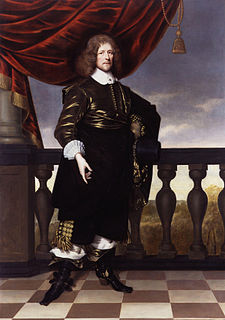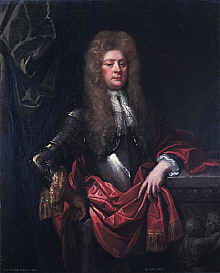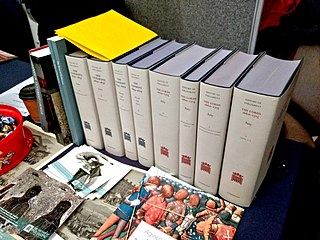External links
- Interview with Dr. Seaward.
Paul Seaward is a British historian specialising in seventeenth century English history. [1]
He is a Director of The History of Parliament Trust. With Martin Dzelzainis, he is General Editor of the Oxford edition of the works of Lord Clarendon. [2]

Edward Hyde, 1st Earl of Clarendon was an English statesman who served as Lord Chancellor to King Charles II from 1658, two years before the Restoration of the Monarchy, until 1667. He was loyal to the king, built up the royalist cause, and served as the chief minister after 1660. He was one of the most important historians of England, as author of the most influential contemporary history of the Civil War, The History of the Rebellion (1702). He was the maternal grandfather of two monarchs, Queen Mary II and Queen Anne.

Earl of Clarendon is a title that has been created twice in British history, in 1661 and 1776.

Charles Middleton, 2nd Earl of Middleton, Jacobite 1st Earl of Monmouth, PC was a Scottish and English politician who held several offices under Charles II and James II & VII. He served as Secretary of State for Scotland, the Northern Department and the Southern Department, before acting as chief advisor to James II and then his son James III during their exile in France.

Cavalier was first used by Roundheads as a term of abuse for the wealthier Royalist supporters of King Charles I and his son Charles II of England during the English Civil War, the Interregnum, and the Restoration. It was later adopted by the Royalists themselves. Although it referred originally to political and social attitudes and behaviour, of which clothing was a very small part, it has subsequently become strongly identified with the fashionable clothing of the court at the time. Prince Rupert, commander of much of Charles I's cavalry, is often considered to be an archetypal Cavalier.

Sir Oliver St John, was an English judge and politician who sat in the House of Commons from 1640 to 1653. He supported the Parliamentary cause in the English Civil War.

John Dalrymple, 1st Earl of Stair was a Scottish politician and lawyer. As Joint Secretary of State in Scotland 1691-1695, he played a key role in suppressing the 1689-1692 Jacobite Rising and was forced to resign in 1695 for his part in the Massacre of Glencoe. Restored to favour under Queen Anne in 1702 and made Earl of Stair in 1703, he was closely involved in negotiations over the 1707 Acts of Union that created the Kingdom of Great Britain but died on 8 January 1707, several months before the Act became law.

Sir Edward Harley KB was an English politician who sat in the House of Commons at various times between 1646 and 1695. He supported the Parliamentary cause in the English Civil War.
The Treaty of Uxbridge of early 1645 was a significant but abortive negotiation to try to end the First English Civil War.

The History of Parliament is a project to write a complete history of the United Kingdom Parliament and its predecessors, the Parliament of Great Britain and the Parliament of England. The history will principally consist of a prosopography, in which the history of an institution is told through the individual biographies of its members. After various amateur efforts the project was formally launched in 1940 and since 1951 has been funded by the Treasury. As of 2019, the volumes covering the House of Commons for the periods 1386–1421, 1509–1629, and 1660–1832 have been completed and published ; and the first five volumes covering the House of Lords from 1660-1715 have been published, with further work on the Commons and the Lords ongoing. In 2011 the completed sections were republished on the internet.
The Treaty of Neutrality signed on 29 September 1642 by Lord Fairfax for Parliament and Henry Bellasis for the Royalists, the two Knights of the Shire who represented Yorkshire in Parliament, with the support and agreement of other gentlemen of the county, in the hope of avoiding civil war in Yorkshire. The treaty was disowned by Parliament on 4 October 1642.
Sir John Bramston, the younger, was an English lawyer and politician who sat in the House of Commons from 1660 to 1679. The son of Sir John Bramston, the elder and his first wife Bridget Moundeford, daughter of Thomas Moundeford, he was educated at Wadham College, Oxford, and called to bar at Middle Temple in 1635. In 1660 he was elected to the Convention Parliament for the county of Essex and again in the Cavalier Parliament of 1661. He frequently acted as chairman of committees of whole House of Commons of England and was returned to parliament for Maldon in 1679 and 1685. He left an autobiography.
Sir Robert Pye (1585–1662) was an English courtier, administrator and politician who sat in the House of Commons between 1621 and 1629. He supported the Royalist cause in the English Civil War.
Nathaniel Stephens was an English politician who sat in the House of Commons at various times between 1628 and 1653. He supported the Parliamentarian cause in the English Civil War.
Lawrence Hyde (1595–1643) was an English lawyer and politician who sat in the House of Commons in two parliaments between 1624 and 1629.
Sir Edward Hungerford was an English landowner and politician who sat in the House of Commons in 1601.
Timothy J. G. Harris is an historian of Later Stuart Britain.

The History of the Rebellion by Edward Hyde, 1st Earl of Clarendon is his account of the English Civil War. This work was the first full-scale, detailed history of the Civil War and was written by a key player in the events contained within it.
The Honourable James Campbell of Burnbank and Boquhan was a Scottish nobleman of Clan Campbell. He was an officer of the Royal Scots Army and then the British Army, and a politician who sat in the Parliament of Scotland from 1699 to 1702 and as a Whig in the British House of Commons from 1708 to 1710.

The Lord High Admirals Council was a series of councils appointed to advise and assist the Lord High Admiral of England and then later of the United Kingdom of Great Britain and Ireland in the direction of Naval Affairs also known as Council of the Lord High Admiral when the Board of Admiralty was not in commission the first series took place between 1702-1708 and second and final series of councils took place from 1827-1828.

The Admiral of the Narrow Seas also known as the Admiral for the guard of the Narrow Seas was a senior Royal Navy appointment. The post holder was chiefly responsible for the command of the English navy's Narrow Seas Squadron also known as the Eastern Squadron that operated in the two seas which lay between England and Kingdom of France and England and the Spanish Netherlands later the Dutch Republic from 1412 to 1688.. His subordinate units, establishments, and staff were sometimes informally known as the Command of the Narrow Seas.